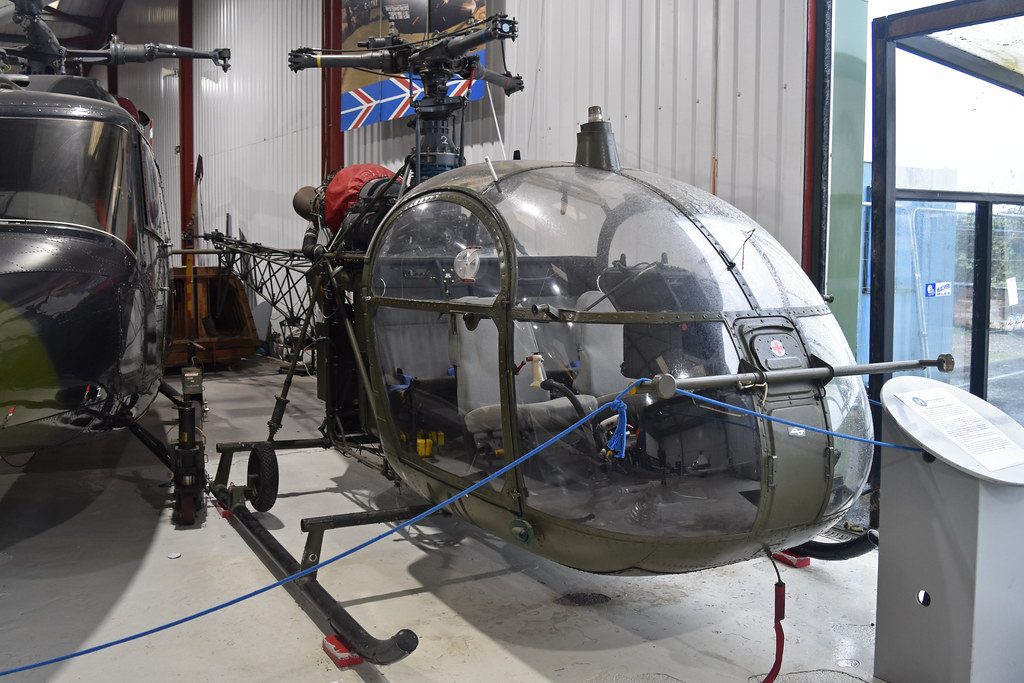#artouste
Text

Chamois (goat-antelope) hunt near Lake Artouste in the Pyrenees Mountains, Béarn region of France
French vintage postcard, mailed in 1909
#antelope#historic#near#1909#hunt#artouste#photo#briefkaart#vintage#pyrenees#sepia#photography#the pyrenees mountains#chamois#carte postale#postcard#mountains#mailed#postkarte#france#postal#tarjeta#ansichtskarte#french#old#lake artouste#ephemera#postkaart#lake#goat
5 notes
·
View notes
Photo
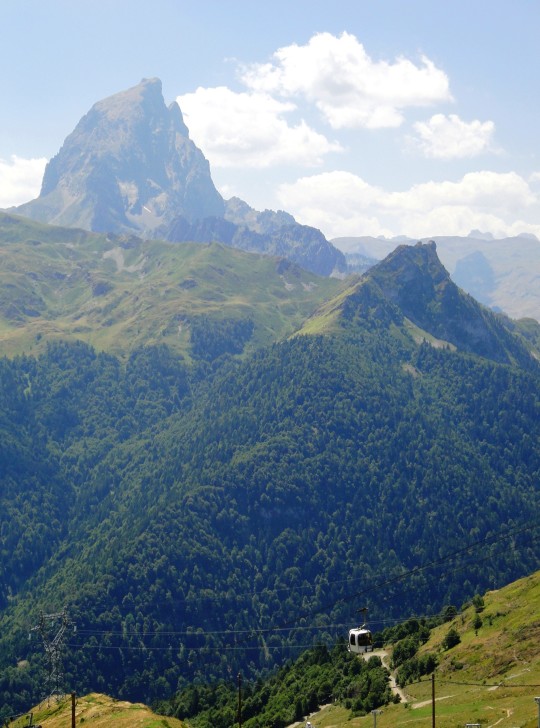



Je reviens à mon projet de présenter la plupart de mes 53280 photos (environ !)
2012. Quelques jours chez Christine, à Pau.
Le terminus du train d’Artouste, face à l’Ossau.
Ensuite, un petit arrêt à Laruns.
#souvenirs#béarn#midi-pyrénées#artouste#train d'artouste#christine#laruns#village#moustache#ossau#pic de l'ossau#pic du midi d'ossau
2 notes
·
View notes
Photo

ARTOUSTE



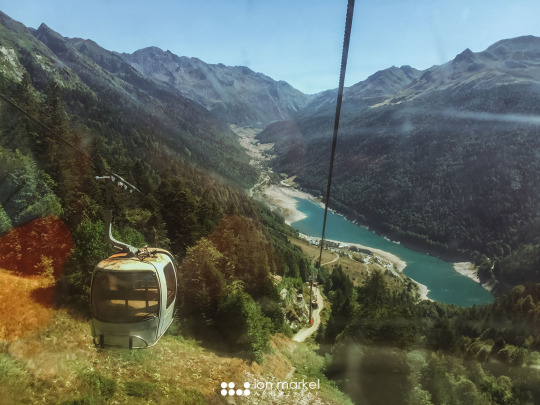
#frantzia#akitania#laruns#artouste#bidaiak#mendiak#ikuspegiak#iphonekeriak#iphone 6 plus#ion markel argazkiak
0 notes
Photo

Strates pyrénéennes, Artouste, 2022
Photographe : Michel STYLITE
7 notes
·
View notes
Text
Pyrénées: à Artouste, un hiver sans neige de culture pour anticiper l'avenir
Economie / finances
0 notes
Text
Tweeted
Recherche de participants pour une étude ! Sujet : "Donnez votre avis sur les prochains projets de la station d'Artouste" https://t.co/iVFGrHNA11 via @SurveyCircle #patrimoine #artouste #montagne #culture #train #questionnaire #sondage #enquête #surveycircle https://t.co/AI0b065zFA
— Daily Research @SurveyCircle (@daily_research) Feb 15, 2023
0 notes
Note
When histortians artousted by music video about Henry Creel, a knight who is hero of country by defated enemy, his charmintisc rule helping bethrtol of his beautfuil bride but on day his wedding Henry was stabbed by Ben Solo work with Lord dathan
Oooh a Stranger Things/Star Wars crossover!
0 notes
Photo
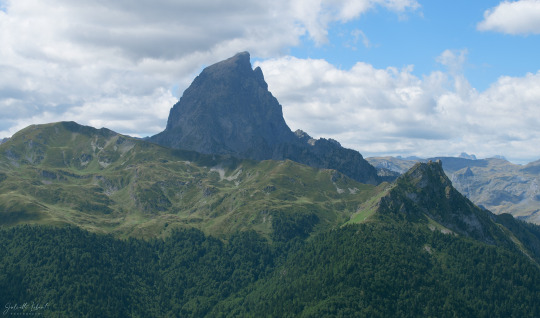
#mountain#mountain photography#landscape#landscape photography#pyrenees mountains#epic mountain landscape#epic landscape#epic mountains#beautiful mountains#mountains of europe#french pyrenees#pic du midi d'ossau#artouste#station artouste fabrèges#amazing mountains#amazing earth
21 notes
·
View notes
Photo

Le train du lac serpente en corniche dans la paroi, Artouste, Pyrénées-Atlantiques, 1970s.
38 notes
·
View notes
Text
FLIGHTLINE: 200 - US ARMY VTOL EXPERIMENTS # 2 - FLYING JEEPS

-The three "Flying Jeeps" of the 1950s. | Collage: Justin Gibb
FLIGHTLINE: 200 - US ARMY VTOL EXPERIMENTS # 2 - FLYING JEEPS
Under development at the same time as the flying platforms, the flying jeeps were intended to give Army soldiers improved mobility.
Concurrent with the HZ-1 Aerocycle and VZ-1 Pawnee, the US Army was investigating larger flying vehicles with even more capability than the Jeep of WWII. In 1956 a request for proposals was filed asking for simple and rugged vehicles capable of flying at altitudes of five to fifteen feet, while carrying one thousand pounds, for several hours at a speed of 70mph. Several firms responded, with Chrysler, Curtiss-Wright and Piasecki being awarded contracts for development of prototypes in 1957.
CHRYSLER VZ-6CH
The first flying jeep was Chrysler's submission, designated the VZ-6CH by the Army, which was a squared off vehicle 21 feet 6 inches long and 5 feet tall, weighing 2,400 pounds gross. A Lycoming 500hp piston engine, mounted in the center, powered two three-bladed 8 foot 6 inch diameter ducted fans mounted fore and aft, while the single pilot's seat was offset to the left. Forward motion was achieved by dropping the nose, with vanes directing the air stream to the rear. Rubber skirts surrounded the bottom of the craft to contain and sustain the cushion of air created, essentially making the VZ-6 one of the first modern hovercraft.

-The first of two VZ-6 prototypes completed. | Photo: Chrysler
Two prototypes (s/n 58-5506 and 58-5507) were delivered to the Army in late 1958, and flight testing of the first began in early 1959. It was immediately apparent during the tether testing stage that the VZ-6 was both overweight and underpowered, with the control systems almost ineffective on top of that. Still, an untethered test was attempted at some point in 1959 (the exact date is unknown), which resulted in the craft flipping over. The pilot escaped without serious injury, but 5506 was written off. Seeing no future in Chrysler's offering, the Army abandoned further testing, and 5507 was scrapped in 1960.
CURTISS-WRIGHT VZ-7AP FLYING TRUCK

-Orthograph of the VZ-7. The tether mounting point would have been replaced by a second seat on production models. | Illustration: Curtiss-Wright
The second design, from Curtiss-Wright, was designated the VZ-7AP, and consisted of a long and narrow central platform (18 feet long, 2 feet wide) with four rotors, two at the extreme aft and two amidships. The pilot sat immediately behind the instrument panel at the front of the frame, with a 30 gallon fuel tank, as well as several oil tanks, behind him. A Turbomeca Artouste IIB turboshaft, rated at 425shp, provided power for the four 2-bladed rotors, each of which was 6 feet 8 inches in diameter. At various points during the test program, the VZ-7s were fitted with either propeller shrouds, guards, or without either. The pilot controlled height by means of a helicopter-style collective, while pitch and yaw were controlled by differentially controlling the rotor pitch. Yaw control was via a vane in the engine exhaust, while an automatic stability augmenter fed by two pitch and roll gyros assisted the pilot. The craft sat on a fixed tricycle undercarriage. Empty weight was 1,160lbs, while projected maximum weight was 2,370lbs. Assuming a pilot weight of 170lbs, 200lbs of cargo could be carried, with provisions to mount either a machine gun or recoilless rifle on the aft deck.

-One of the VZ-7s during a test flight, with a mockup recoilless gun mounted on the platform. | Photo: US Army
Two prototypes (s/n 58-5508 and 58-5509) were delivered to the Army in mid-1958, with test flights commencing soon afterwards. During both the builders trials and the Army's acceptance testing the VZ-7s performed adequately, proving to be stable in both hovering and during forward flight, and establishing a ceiling of 200 feet and a max speed of 32-3mph. Still, the Army was unsatisfied with the apparent fragility of the vehicle, as well as the inability to meet program goals, and withdrew both in 1960. The second prototype was returned to Curtiss-Wright, and was apparently scrapped, while the first remains in storage at the US Army Aviation Museum at Fort Rucker, Alabama.
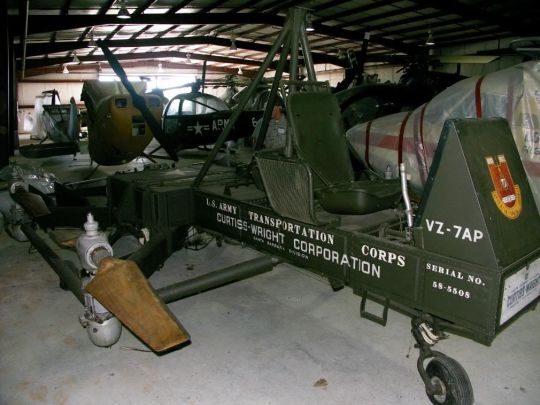
-The first VZ-7AP remains in storage pending restoration and display space. | Photo: US Army
youtube
PIASECKI VZ-8 AIRGEEP
Piasecki received the third and final prototype construction contract, with their PA-59K Skycar being designated the VZ-8P Airgeep. roughly similar to Chrysler's offering, the Airgeep featured two ducted fans on either end of the frame, with the pilots and two engines in the middle. Control was via pitch adjustment, augmented with movable vanes in the downdraft, while forward speed was adjusted by tilting the craft forwards and backwards. The second prototype was completed to an improved specification, with a more powerful engine and with seating for three passengers added.
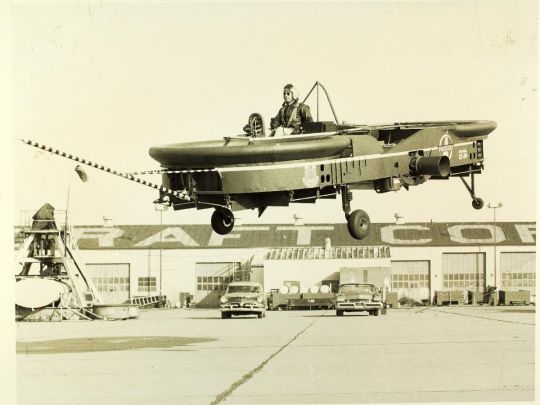
-The Airgeep I on its maiden flight. | Photo: San Diego Air and Space Museum Archive
The VZ-8 (s/n 58-5510) was 26 feet long and 9 feet wide and stood almost 7 feet tall on fixed reverse tricycle undercarriage. Two Lycoming O-360-A2A piston engines, each rated at 180hp, drove the two 3-bladed rotors, each of which was 8 feet in diameter. The engines were cross-linked so that if one failed the other would drive both rotors, providing a measure of safety. The maiden flight of the Airgeep I was on 22 September 1958, with the first free flight taking place in October of that year, after which it was turned over the Army for their evaluation. Initial flights were underwhelming, with the Skycar barely able to fly over fencing, and in 1959 a Turbomeca Artouste IIB turboshaft replaced the Lycomings, with the first flight of the modified vehicle occuring in June. The modification proved to be just what the Airgeep needed, as although the weight was now 2,500lbs, the craft could now carry a payload of nearly 1,200lbs, including the pilot. After the Army completed its flights, the first VZ-8 was refitted with pontoons and loaned to the Navy as the PA-59N Seageep for their evaluation, with the first flight on 18 September 1961. After the Navy tests were concluded, the Airgeep I was returned to Piasecki, where the Turbomeca engine was replaced by a lighter and more powerful Garett AiResearch/Honeywell TPE331-6 turboshaft for further Army testing.

-The PA-59N, with inflatable pontoons replacing the landing gear, on its maiden flight. | Photo: San Diego Air and Space Museum Archive
Work was also being completed on the second prototype (s/n 58-5511), which had been revised to incorporate changes informed by the early builders trials and Army eval. Known as the PA-59H Airgeep II by Piasecki and the VZ-8P (B) (some sources say VZ-8P-2) by the Army, the second vehicle was 24 feet 6 inches long by 10 feet wide, and stood 5 feet 8 inches tall. The frame aft of the pilots' seats was bent upwards compared to the 59K to improve forward speed. Power was provided by two Artouste IIC turboshafts of 550shp each, which increased the Airgeep II's speed to 85mph, and the max ceiling to 3,000 feet. As before, the engines were linked to provide a fail-safe, and a new system allowed one of the engines to drive the landing gear wheels, giving the 59H mobility on the ground to improve fuel efficiency. Both the pilot and observer/gunner were provided zero/zero ejection seats, and three additional fixed seats could be added for passengers. First flight of the Airgeep II was on 15 February 1962.

-The VZ-8P (B) on its maiden flight. | Photo: San Diego Air and Space Museum Archive

-Both of the VZ-8P Airgeeps at Piasecki's plant in Philadelphia. | Photo: Piasecki Aircraft
Despite the improved performance of the Airgeep II, the Army had lost interest in the "flying jeep" idea, citing the thirst of early turboshafts, the fragility of the designs provided, the inability to meet program goals, and a lack of an identifiable role. The Airgeeps were withdrawn circa 1963. The fate of first prototype is unknown, but the PA-59K, s/n 58-5511, is on display at the US Army Aviation Museum.

youtube
#Aviation#avgeek#vtol#flying jeep#airgeep#us army#the fifties#the 50s#Cold War#cold war history#coldwar#piasecki#chrysler#curtiss wright
20 notes
·
View notes
Video
Sud SA.318C Alouette II ‘A41’ by Alan Wilson
Via Flickr:
c/n 1958 Built 1967 for the Belgian Army where she flew with the serial A41 and the callsign OT-ACB. She joined the museum in 2008. The Helicopter Museum Weston-super-Mare, North Somerset, UK 2nd October 2020 The following information is from The Helicopter Museum website:- “Originally developed as a four seat piston-engined helicopter, the Alouette 1 first flew in 1953 but was soon completely redesigned to take advantage of the new turboshaft engine. Pioneered by Joseph Szydlowski, founder of the French company Turbomeca, his new 360shp Artouste engine took advantage of the jet engine principle, adding a shaft to the basic concept to drive the helicopter rotor system. As the SE130 Alouette 2, the new helicopter first flew on 12 of March 1955 and in 1956 became the first turbine-powered helicopter in the world to enter production. Almost immediately one of the first aircraft carried out the world's first high altitude mountain resuce, evacuating the victim of a heat attack from a 4,000m high plateau in the French Alps on 3rd July 1956 The extra performance available revolutionised the use of the helicopter, particularly in hot countries and mountainous regions and versions of the Alouette 2 were soon setting world records, including an initial altitude record in 1958 of 10,984m (36,131ft). In 1972 one variant, the SA315B Lama, established a new aboslute altitude record for helicopters of 12,442m (40,820ft) on 21st June 1972. The official record still stands today In 1961 the SA3180 (later SA318C) variant was introduced with the more powerful Astazou engine and the type continued to be manufactured until 1975. 1324 Alouette 2s were built over the 20 years it was in production. The aircraft on display is an SA318C, built in 1967 and previously operated by the Belgian Army in the reconnaissance, communications, medivac and training role. It was delivered to the Museum on 19th February 2008.
8 notes
·
View notes
Photo
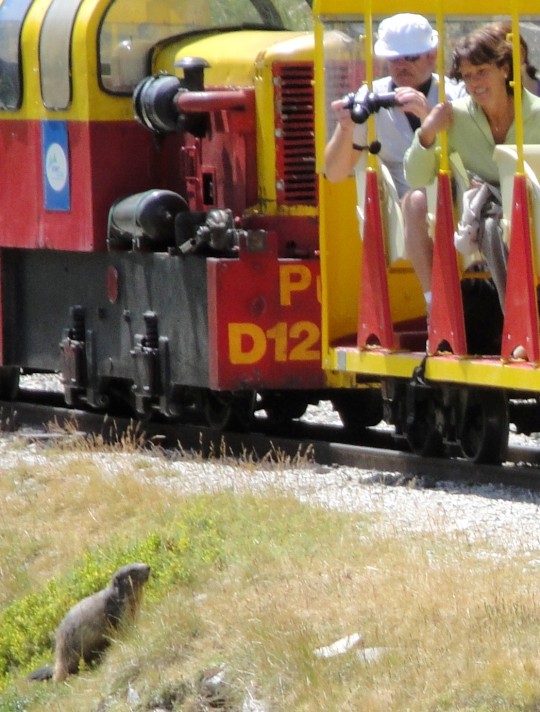
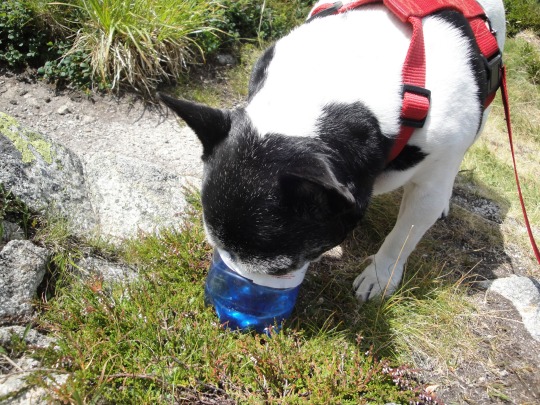




Je reviens à mon projet de présenter la plupart de mes 53280 photos (environ !)
2012. Quelques jours chez Christine, à Pau.
Vers le lac d’Artouste et au retour : Sapho et des marmottes (dont une, géante !!). Bon sur les photos 3 et 5, il faut les repérer...
0 notes
Text
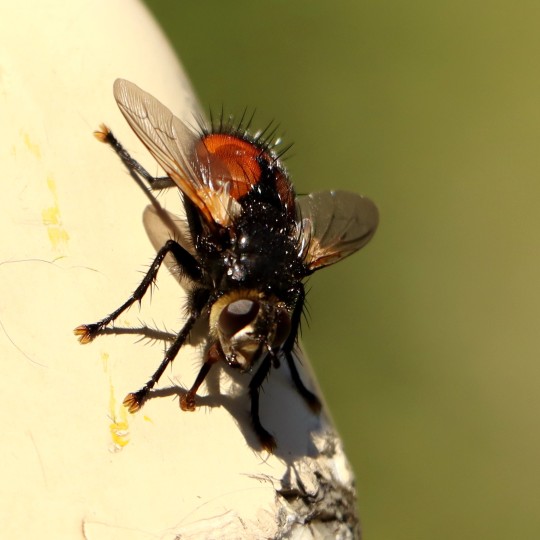
Quel insecte à 2100m? , Artouste, 2022
Photographie : Michel STYLITE
6 notes
·
View notes
Photo

ARTOUSTE LAKE 4.. FRENCH PYRÉNÉES 65 FRANCE... by Tailleur //
0 notes
Photo

#mountains #pyrenees #autumn #hiking #colors #ossau #lurien #artouste #landscape https://www.instagram.com/p/BotUKFEAbSh/?utm_source=ig_tumblr_share&igshid=1bi3e4530fsko
0 notes
Video
vimeo
Valle D´Ossau, Pequeño tren de Artouste y refugio de Arremoulit (Francia) Situación: Valle D´Ossau, Artouste (Francia) Época para visitarlo: Abierto del 19 de Mayo al 30 de Octubre.
#55 minutos#Artouste#billete caminante#Camping Pyrenees Nature#Catedral de Santa María de Olorón#Francia#Haunt-Bearn#Lac de Fabrèges#naturaleza#Oloron-Sainte-Marie#pequeño tren#petit train#Pirineos#Puerta de los Pirineos#Refuge d&039;Arremoulit#refugio de Arremoulit#ruta#sendero#Teleférico#temporada
0 notes
